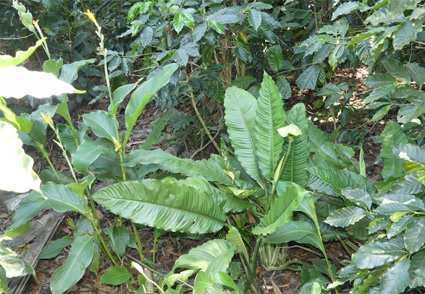Abstract
The genus Spathiphyllum is represented in Mexico by 11 species, four of which are registered for the state of Veracruz. As a result of the revision of material collected in Los Tuxtlas, Veracruz, in addition to a detailed review of herbarium specimens, and comparison to individuals collected at and the type locality of Spathiphyllum cochlearispathum, we determined that the Spathiphyllum species identified as S. cochlearispathum in the Gulf of Mexico corresponds to a different species, not previously designated. The new species, Spathiphyllum croatii, is described taxonomically, illustrated, and compared with S. cochlearispathum.
References
Adanson, M. (1763) Familles des Plantes 2 Vols. Paris, 640 pp.
Bachman, S., Moat, J., Hill, A.W., de la Torre, J. & Scott, B. (2011) Supporting Red List threat assessments with GeoCAT: geospatial conservation assessment tool. In: Smith, V. & Penev, L. (Eds.) e-Infrastructures for data publishing in biodiversity science. ZooKeys 150: 117–126. https://doi.org/10.3897/zookeys.150.2109
Bown, D. (2000) Aroids. Plants of the Arum Family. Timber Press, Portland, 392 pp.
Boyce, P.C. & Croat, T.B. (2020) The Überlist of Araceae, totals for published and estimated number of species in aroid genera. Available from: http://www.aroid.org/genera/20201008Uberlist.pdf (accessed 1 September 2021)
Bunting, G.S. (1960) A revision of Spathiphyllum (Araceae). Memoirs of the New York Botanical Garden 10: 1–53.
Bunting, G.S. (1965) Commentary on Mexican Araceae. Gentes Herbarum 9: 291–382.
Cardona, F. (2004) Synopsis of the genus Spathiphyllum (Araceae) in Colombia. Annals of the Missouri Botanical Garden 91: 448–456.
Croat, T.B. (1998) Tropical aroids: taxonomy, diversity and ecology. In: Mathew, P. & Sivadasan, M. (Eds.) Diversity and Taxonomy of Tropical Flowering Plants. Mentor, Calicut, pp. 235–286.
Croat, T.B. & Acebey, A. (2015) Araceae. In: Flora de Veracruz. Fascículo 164. Instituto de Ecología A, C., Centro de Investigaciones Tropicales, Universidad Veracruzana, Xalapa, 211 pp.
Díaz Jiménez, P., Hentrich, H., Ruiz-Idarraga, J.M., Gibernau, M. & Zuluaga, A. (2019a) The exceptional flowering behaviour of Spathiphyllum grandifolium ENGL. (Araceae) – an indicator for self-pollination? Ecotropica 21: 1–5.
Díaz Jiménez, P., Hentrich, H., Aguilar-Rodríguez, P.A., Krömer, T., Chartier, M., MacSwiney-G., M.C. & Gibernau, M. (2019b) A review on the pollination of aroids with bisexual flowers. Annals of the Missouri Botanical Garden 104: 83–104. https://doi.org/10.3417/2018219
Engler, A. (1879) Araceae. In: De Candolle, A. & De Candolle, C. (Eds.) Monographiae Phanoerogamorum 2: 1–681.
Engler, A. (1905) Beiträge zur Kenntnis der Araceae. X. Botanische Jahrbücher für Systematik, Pflanzengeschichte und Pflanzengeographie 37: 110–143.
IUCN (2012) The IUCN Red List categories and criteria: Version 3.1, 2nd ed. IUCN Species Survival Commission. Gland, Switzerland and Cambridge, UK. Available from: https://portals.iucn.org/library/sites/library/files/documents/RL-2001-001-2nd-Es.pdf (accessed 11 May 2021)
Liebmann, F. (1849) Om Mexicos Aroideer. Videnskabelige Meddelelser fra Dansk Naturhistorisk Forening i Kjøbenhavn (1–2): 11–25.
Mayo, S.J., Bogner, J. & Boyce, P.C. (1997) The genera of Araceae. Royal Botanical Garden, Kew, London, 370 pp.
Montalvo, A.M. & Ackerman, J.D. (1986) Relative pollinator effectiveness and evolution of floral traits in Spathiphyllum friedrichsthalii (Araceae). American Journal of Botany 73: 1665–1676. https://doi.org/10.1002/j.1537-2197.1986.tb09697.x
Poeppig, E. (1845) Nova genera ac species plantarum, quas in regno Chilensi Peruviano et in terra Amazonica 3. Sumptibus F. Hofmeister, Leipzig, 91 pp.
Regel, E. (1870) Gartenflora 19. Verlag von Ferdinand Enke, Erlangen, 394 pp.
Royal Botanical Gardens Kew (2021) GeoCAT: Geospatial Conservation Assessment Tool. Available from: http://geocat.kew.org/ (accessed 8 May 2021)
Schott, H.W. (1829) Fu?r Liebhaber der Botanik. Wiener Zeitschrift fur Kunst, Litteratur, Theater und Mode 3: 828.
Schott, H.W. (1853) Aroideae 1. Gerold, Vienna, 2. https://doi.org/10.5962/bhl.title.118627
Schott, H.W. 1858. Genera Aroidearum exposita. Typis Caroli Ueberreuter, Vindobonae. https://doi.org/10.5962/bhl.title.42216
Schott, H.W. & S. Endlicher (1832) Meletemata Botanica. Typis Caroli Gerold, Vindobonae, 36 pp.
Zuluaga, A., Cameron, K., Croat, T.B. & Medecilo, M.M. (2015) Testing the monophyly of Spathiphyllum, and the relationship between Asian and tropical American species. Aroideana 38: 107–115.


